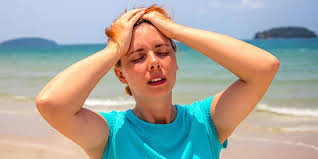Warning Signs and Symptoms of Heat-Related Illness
As the temperatures rise, it's crucial to be aware of the warning signs and symptoms of heat-related illnesses. Heat-related illnesses can range from mild discomfort to life-threatening conditions, making it essential to recognize the early signs and take immediate action. In this blog post, we will explore the various heat-related illnesses and their associated warning signs and symptoms. By understanding these indicators, you can protect yourself and others from the potentially dangerous effects of extreme heat.
As per Centers for Disease Control, Heat-related illnesses are preventable. Learn the symptoms and what to do if you or a loved one shows signs of having a heat-related illness.
Also see: 7 Common Summer Medical Emergencies and How to Avoid Them
1. Heat Exhaustion.
Heat exhaustion is a common heat-related illness that occurs when the body becomes overheated and fails to regulate its temperature effectively. The warning signs and symptoms of heat exhaustion may include:
- Heavy sweating and feeling excessively thirsty
- Fatigue and weakness
- Dizziness or lightheadedness
- Headache
- Nausea or vomiting
- Muscle cramps or weakness
- Cool, moist skin with goosebumps, despite the heat
- Rapid heartbeat
If you or someone around you experience these symptoms, it is crucial to move to a cool, shaded area, rest, and rehydrate by drinking cool fluids. Applying cold compresses and taking a cool shower may also help alleviate symptoms. If the symptoms worsen or do not improve within an hour, seek medical attention promptly.
Also see: When to go to the ER for Dehydration
2. Heat Stroke.
Heat stroke is a severe and potentially life-threatening condition that requires immediate medical attention. It occurs when the body's temperature regulation system fails, and the body temperature rises to a dangerous level. The warning signs and symptoms of heat stroke may include:
- High body temperature (above 103°F or 39.4°C)
- Altered mental state, confusion, or disorientation
- Rapid and shallow breathing
- Rapid heartbeat and elevated blood pressure
- Headache, dizziness, or fainting
- Nausea or vomiting
- Red, hot, and dry skin (no sweating)
Heat stroke is a medical emergency. Call for emergency medical assistance immediately if you suspect someone is experiencing heat stroke. While waiting for help, move the person to a shaded area, remove excess clothing, and attempt to cool them by applying cool water or wet towels to their body. Do not give fluids to an unconscious person.
Also see: Heat Stroke Symptoms and Treatment
3. Heat Cramps.
Heat cramps are painful muscle contractions that typically occur during intense physical activity in hot environments. The warning signs and symptoms of heat cramps may include:
- Intense muscle pain or spasms, usually in the legs or abdomen
- Sweating heavily
- Fatigue
If you experience heat cramps, stop the activity, move to a cooler place, and rest. Drink cool fluids containing electrolytes to rehydrate and replenish minerals lost through sweating. Gentle stretching or massaging the affected muscles may help alleviate the cramps. If the cramps persist or worsen, seek medical attention.
Also see: How to Beat Summer Allergies
4. Heat Rash.
Heat rash, also known as prickly heat, is a skin condition caused by blocked sweat ducts. It commonly occurs in hot and humid conditions, especially in areas where sweat is trapped against the skin. The warning signs and symptoms of heat rash may include:
- Red clusters of small bumps or blisters
- Itchy or prickly sensation
- Mild swelling
To relieve heat rash, move to a cooler and less humid environment. Keep the affected area clean and dry, and wear lightweight, breathable clothing. Calamine lotion or over-the-counter hydrocortisone cream can help soothe the itchiness. If the rash persists or worsens, consult a healthcare professional. If you think that someone is suffering from heatstroke, heat cramps, and heat rash, you should immediately visit or call the closest emergency room for the medical help.
We have ER locations across the DFW metroplex that are open and here to help you 24/7 If you or your family have a medical emergency.
We have 9 facilities spread across the DFW area with average wait times of less than 10 mins that are OPEN 24/7 located in Hurst, Colleyville, Frisco, Highland Village, Hillcrest, Uptown, Little Elm, Mansfield, and Texoma.



.jpg)